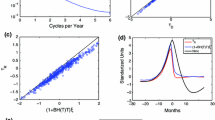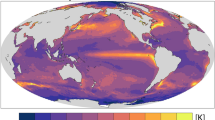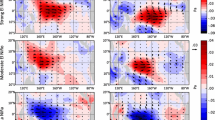Abstract
Stochastic forcing has been used conceptually to explain ENSO irregularity. More recently, the concept of state-dependent (multiplicative) stochastic forcing has been explored as an explanation of a number of ENSO properties. By calculating the state-dependence factor of ENSO zonal wind stress noise forcing on SST, we are able to separate the additive and multiplicative components of the wind stress noise forcing of ENSO. Spatially, the months with large additive or multiplicative components all resemble previous studies on westerly wind bursts. They differ from each other in that the wind stresses are significantly stronger during months with a large multiplicative noise component. It is further shown that when the multiplicative noise component is large, there have been large values of the wind stress noise in the preceding months. This is not true of the months when the additive component is large. The multi-month growth of the wind stress from the multiplicative noise process is shown to be related to an eastward migration of the western Pacific Warm Pool, which is coupled to the wind stress through convection. This process is shown to be significantly weakened in a climate model when the ocean and atmosphere are uncoupled.













Similar content being viewed by others
References
Adler RF, Huffman GJ, Chang A, Ferraro R, Xie PP, Janowiak J, Rudolf B, Schneider U, Curtis S, Bolvin D et al (2003) The version-2 global precipitation climatology project (GPCP) monthly precipitation analysis (1979–present). J Hydrometeorol 4(6):1147–1167
Balmaseda MA, Vidard A, Anderson DL (2008) The ECMWF ocean analysis system: ORA-S3. Mon Weather Rev 136(8):3018–3034
Battisti DS, Hirst AC (1989) Interannual variability in the tropical atmosphere/ocean system: influence of the basic state and ocean geometry. J Atmos Sci 46:1697–1712
Chiodi AM, Harrison DE, Vecchi GA (2014) Subseasonal atmospheric variability and El Niño waveguide warming: observed effects of the Madden-Julian Oscillation and westerly wind events. J Clim 27(10):3619–3642
Choi K, Vecchi GA, Wittenberg A (2013) ENSO transition, duration, and amplitude asymmetries: role of the nonlinear wind stress coupling in a conceptual model. J Clim 26(23):9462–9476
Delworth TL et al (2006) GFDL’s CM2 global coupled climate models. Part I: formulation and simulation characteristics. J Clim 19:643–674
Deser C, Phillips AS, Tomas RA, Okumura YM, Alexander MA, Capotondi A, Scott JD, HKwon YO, Ohba M (2012) ENSO and Pacific decadal variability in the community climate system model version 4. J Clim 25(8):2622–2651
Drushka K, Bellenger H, Guilyardi E, Lengaigne M, Vialard J, Madec G (2015) Processes driving intraseasonal displacements of the eastern edge of the warm pool: the contribution of westerly wind events. Clim Dyn 44(3–4):735–755
Eisenman I, Yu L, Tziperman E (2005) Westerly wind bursts: ENSO’s tail rather than the dog? J Clim 18:5224–5238
Gebbie G, Tziperman E (2009a) Incorporating a semi-stochastic model of ocean-modulated westerly wind bursts into an ENSO prediction model. Theor Appl Climatol 97(1–2):65–73
Gebbie G, Tziperman E (2009b) Predictability of SST-modulated westerly wind bursts. J Clim 22:3894–3909
Gebbie G, Eisenman I, Wittenberg A, Tziperman E (2007) Modulation of westerly wind bursts by sea surface temperature: a semistochastic feedback of ENSO. J Atmos Sci 64:3281–3295
Gent PR, Danabasoglu G, Donner LJ, Holland MM, Hunke EC, Jayne SR, Lawrence DM, Neale RB, Rasch PJ, Vertenstein M, Worley PH, Yang ZL, Zhang M (2011) The community climate system model version 4. J Clim 24(19):4973–4991
Gill A (1980) Some simple solutions for heat-induced tropical circulation. Q J R Meteorol Soc 106:447–462
Graham FS, Brown JN, Langlais C, Marsland SJ, Wittenberg AT, Holbrook NJ (2014) Effectiveness of the Bjerknes stability index in representing ocean dynamics. Clim Dyn (in press). doi:10.1007/s00382-014-2062-3
Hu S, Fedorov AV (2016) Exceptionally strong easterly wind burst stalling El Niño of 2014. Proc Natl Acad Sci USA 113(8):2005–2010
Jin FF (1997) An equatorial ocean recharge paradigm for ENSO. Part I: conceptual model. J Atmos Sci 54:811–829
Jin FF, Pan LL, Watanabe M (2006) Dynamics of synoptic eddy and low-frequency flow feedback. Part I: a dynamic closure. J Atmos Sci 64:1677–1694
Jin FF, Lin L, Timmermann A, Zhao J (2007) Ensemble-mean dynamics of the ENSO recharge oscillator under state dependent stochastic forcing. Geophys Res Lett 34(L03):807. doi:10.1029/2006GL027372
Keen R (1982) The role of cross-equatorial cyclone pairs in the Southern Oscillation. Mon Weather Rev 119:1405–1416
Kessler WS, Kleeman R (2000) Rectification of the Madden–Julian Oscillation in to the ENSO cycle. J Clim 13:3560–3575
Kessler WS, McPhaden MJ, Weickmann KM (1995) Forcing of intraseasonal Kelvin waves in the equatorial Pacific. J Geophys Res 100:10,613–10,631
Kim ST, Jin FF (2011a) An ENSO stability analysis. Part I: results from a hybrid coupled model. Clim Dyn 36(7–8):1593–1607
Kim ST, Jin FF (2011b) An ENSO stability analysis. Part II: results from the twentieth and twenty-first century simulations of the CMIP3 models. Clim Dyn 36(7–8):1609–1627
Kirtman BP, Pegion K, Kinter SM (2005) Internal atmospheric dynamics and tropical indo-pacific climate variability. J Atmos Sci 62(7):2220–2233
Kleeman R, Moore AM (1997) A theory for the limitation of ENSO predictability due to stochastic atmospheric transients. J Atmos Sci 54:753–767
Kug JS, Jin FF, Sooraj KP, Kang IS (2008) State-dependant atmospheric noise associated with ENSO. Geophys Res Lett 35(L05):701. doi:10.1029/2007GL032017
Lengaigne M, Guilyardi E, Boulanger JP, Menkes C, Delecluse P, Inness P, Cole J, Slingo J (2004) Triggering El Niño by westerly wind events in a coupled general circulation model. Clim Dyn 23:601–620
Levine AFZ, Jin FF (2010) Noise-induced instability in the ENSO recharge oscillator. J Atmos Sci 67:529–542
Levine AFZ, Jin FF (2015) A systematic approach to understanding the noise–ENSO interaction. Part I: a method for estimating the state-dependence of noise. Clim Dyn 1–18. doi:10.1007/s00382-015-2748-1
Levine AF, McPhaden MJ (2015) The annual cycle in ENSO growth rate as a cause of the spring predictability barrier. Geophys Res Lett 42(12):5034–5041. doi:10.1002/2015GL064309
Levine AFZ, Jin FF, McPhaden MJ (2016) Extreme Noise-Extreme El Niño: How state-dependent noise forcing creates El Niño-La Niña asymmetry. J Clim. doi:10.1175/JCLI-D-16-0091.1
Lopez H, Kirtman BP (2013) Westerly wind bursts and the diversity of ENSO in CCSM3 and CCSM4. Geophys Res Lett 40(17):4722–4727
Lopez H, Kirtman BP, Tziperman E, Gebbie G (2013) Impact of interactive westerly wind bursts on CCSM3. Dyn Atmos Oceans 59:24–51
McPhaden MJ (1999) Genesis and evolution of the 1997–1998 El Niño. Science 283:950–954
McPhaden MJ (2002) Mixed layer temperature balance on intraseasonal timescales in the Equatorial Pacific Ocean. J Clim 15(18):2632–2647
McPhaden MJ, Freitag HP, Hayes SP, Taft BA, Chen Z, Wyrtki K (1988) The response of the equatorial Pacific Ocean to a westerly wind burst in May 1986. J Geophys Res Oceans 93(C9):10,589–10,603
Menkes CE, Lengaigne M, Vialard J, Puy M, Marchesiello P, Cravatte S, Cambon G (2014) About the role of westerly wind events in the possible development of an El Niño in 2014. Geophys Res Lett 41(18):6476–6483
Moore AM, Kleeman R (1999) Stochastic forcing of ENSO by the intraseasonal oscillation. J Clim 12:1199–1220
Moore AM, Kleeman R (2001) The differences between the optimal perturbation of coupled models of ENSO. J Clim 14:138–163
Moore AM, Vialard J, Weaver AT, Anderson DL, Kleeman R, Johnson JR (2003) The role of air–sea interaction in controlling the optimal perturbations of low-frequency tropical coupled ocean–atmosphere modes. J Clim 16(6):951–968
Penland C (1996) A stochastic model of IndoPacific sea surface temperature anomalies. Phys D 98:534–558
Penland C, Sardeshmukh PD (1995) The optimal growth of tropical sea surface temperature anomalies. J Clim 8:1999–2024
Perez CL, Moore AM, Zavala-Garay J, Kleeman R (2005) A comparison of the influence of additive and multiplicative stochastic forcing on a coupled model of ENSO. J Clim 18:5066–5085
Picaut J, Masia F, Du Penhoat Y (1997) An advective–reflective conceptual model for the oscillatory nature of the ENSO. Science 277(5326):663–666
Puy M, Vialard J, Lengaigne M, Guilyardi E (2016) Modulation of equatorial Pacific westerly/easterly wind events by the Madden–Julian oscillation and convectively-coupled Rossby waves. Clim Dyn 46(7–8):2155–2178
Rayner NA, Parker DE, Horton EB, Folland CK, Alexandre L, Rowell DP, Kent EC, Kaplan A (2003) Global analyses of sea surface temperature, sea ice an night marine air temperature since the late nineteenth century. J Geophys Res 108(D14):4407
Roulston MS, Neelin JD (2000) The response of an ENSO model to climate noise, weather noise and intraseasonal forcing. Geophys Res Lett 27(22):3723–3726
Sardeshmukh PD, Sura P (2009) Reconciling non-Gaussian climate statistics with linear dynamics. J Clim 22:1193–1207
Seiki A, Takayabu YN (2007) Westerly wind bursts and their relationship with intraseasonal variations and ENSO. Part I: statistics. Mon Weather Rev 135(10):3325–3345
Stuecker MF, Timmermann A, Jin FF, McGregor S, Ren H (2013) A combination mode of the annual cycle and the El Niño/Southern oscillation. Nat Geosci 6:540–544
Stuecker MF, Jin FF, Timmermann A, McGregor S (2015) Combination mode dynamics of the anomalous northwest Pacific anticyclone. J Clim 28:1093–1111
Suarez MJ, Schopf PS (1988) A delayed action oscillator for ENSO. J Atmos Sci 45:3283–3287
The GFDL Global Atmospheric Model Development Team (2004) The new GFDL global atmosphere and land model AM2-LM2: evaluation with prescribed SST simulations. J Clim 17:4641–4673
Tziperman E, Yu L (2007) Quantifying the dependence of westerly wind bursts on the large-scale tropical Pacific SST. J Clim 20:2760–2768
Uppala SM, Kallberg PW, Simmons AJ, Andrae U, da Costa Bechtold V, Fiorino M, Gibson JK, Haseler J, Hernandez A, Kelly GA, Li X, Onogi K, Saarinen S, Sokka N, Allan RP, Andersson E, Arpe K, Balmaseda MA, Beljaars ACM, van de Berg L, Bidlot J, Bormann N, Caires S, Checallier F, Dethof A, Dragosavac M, Fisher M, Fuentes M, Hagemann S, Holm E, Hoskins BJ, Isaksen L, Janssen PAEM, Jenne R, McNally AP, Mahfouf JF, Morcrette JJ, Rayner NA, Saunders RW, Simon P, Sterl A, Trenberth KE, Untch A, Vasiljevic D, Viterbo P, Woolen J (2005) The ERA-40 reanalysis. Q J R Meteorol Soc 131:2961–3012
Vecchi G, Wittenberg A, Rosati A (2006) Reassessing the role of stochastic forcing in the 1997–1998 El Niño. Geophys Res Lett 33(1):1–4. doi:10.1029/2005GL024738
Vecchi GA, Harrison DE (2000) Tropical Pacific sea surface temperature anomalies, El Niño and equatorial westerly events. J Clim 13:1814–1830
Vialard J, Menkes C, Boulanger JP, Delecluse P, Guilyardi E, McPhaden MJ, Madec G (2001) A model study of oceanic mechanisms affecting equatorial Pacific sea surface temperature during the 1997–1998 El Nino. J Phys Oceanogr 31:1649–1675
Wu R, Kirtman BP, Pegion K (2006) Local air–sea relationship in observations and model simulations. J Clim 19(19):4914–4932
Yu L, Weller RA, Liu TW (2003) Case analysis of a role of ENSO in regulating the generation of westerly wind bursts in the western equatorial Pacific. J Geophys Res 108(C4):3128. doi:10.1029/2002JC001498
Zavala-Garay J, Moore AM, Perez CL, Kleeman R (2003) The response of a coupled model of ENSO to observed estimates of stochastic forcing. J Clim 16:2827–2842
Zavala-Garay J, Moore AM, Kleeman R (2004) Influence of stochastic forcing on ENSO prediction. J Geophys Res 109:C1107. doi:10.1029/2004JC002406
Zavala-Garay J, Zhang C, Moore AM, Kleeman R (2005) The linear response of ENSO to the Madden–Julian oscillation. J Clim 18:2441–2459
Zavala-Garay J, Zhang C, Moore AM, Wittenberg A, Harrison MJ, Rosati A, Vialard J, Kleeman R (2008) Sensitivity of hybrid ENSO models to unresolved atmospheric variability. J Clim 21:3704–3721
Acknowledgments
This work was supported by NSF Grant AGS-1034798, Department of Energy Grant DE-SC0005110 and NOAA Grant NA10OAR4310200. The authors would like to express thanks to C. Karamperidou and A. Timmermann for their helpful discussions and three anonymous reviewers for their comments.
Author information
Authors and Affiliations
Corresponding author
Rights and permissions
About this article
Cite this article
Levine, A.F.Z., Jin, F.F. & Stuecker, M.F. A simple approach to quantifying the noise–ENSO interaction. Part II: the role of coupling between the warm pool and equatorial zonal wind anomalies. Clim Dyn 48, 19–37 (2017). https://doi.org/10.1007/s00382-016-3268-3
Received:
Accepted:
Published:
Issue Date:
DOI: https://doi.org/10.1007/s00382-016-3268-3




